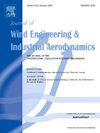对多种风速下风引起的桥梁响应进行非线性非稳定空气动力预测和气动弹性分析:基于深度学习的降阶模型
IF 4.2
2区 工程技术
Q1 ENGINEERING, CIVIL
Journal of Wind Engineering and Industrial Aerodynamics
Pub Date : 2024-10-02
DOI:10.1016/j.jweia.2024.105905
引用次数: 0
摘要
基于机器学习的空气动力学降阶模型(ROM)兼具高精度和极低的计算成本,因此在预测非线性和非稳态桥梁空气动力方面非常有效。虽然已经开发了多个基于机器学习的非线性空气动力学模型,但大多数模型都是基于单一风速参数建立的。然而,在桥梁的非线性气动力预测和气动弹性分析中,风速的变化会对计算结果产生重大影响。仅依靠单一风速的 ROM 无法准确预测风速变化引起的复杂动态行为。当进入的风速发生变化时,模型的预测精度会明显降低。通常情况下,需要建立新的数据库并训练新的模型,这不仅增加了时间和成本,还大大降低了 ROM 的便利性。针对这一难题,本研究提出了一种基于 LSTM 深度神经网络的多风速(MWS)非线性非稳态桥梁空气动力学模型。以中国河南省桃花峪黄河大桥为例,演示了所提出的 MWS-ROM 的建模过程,以及不同条件下桥面的非线性气动预测和不同风速下桥面的气动弹性分析。研究结果表明,训练有素的 LSTM 网络可以准确预测单自由度和双自由度振动条件下桥梁的非线性空气动力。MWS-ROM 在预测低风速下的收敛振动和高风速下的极限周期振荡方面表现出色,与 CFD 全阶模型的结果非常接近。与 CFD 相比,基于 LSTM 网络的气动 ROM 显著提高了计算效率,从而提高了桥梁飘移分析的便利性和效率。此外,本文提出的方法还可扩展用于其他类型桥面截面的风致振动控制和响应预测。本文章由计算机程序翻译,如有差异,请以英文原文为准。
Nonlinear unsteady aerodynamic forces prediction and aeroelastic analysis of wind-induced bridge response at multiple wind speeds: A deep learning-based reduced-order model
Machine learning-based aerodynamic reduced-order models (ROMs) combine high accuracy with extremely low computational costs, making them highly effective in predicting nonlinear and unsteady bridge aerodynamic forces. Although several machine learning-based nonlinear aerodynamic models have been developed, the majority are built on a single wind speed parameter. However, in nonlinear aerodynamic prediction and aeroelastic analysis of bridges, the variability in incoming wind speed significantly influences the computed results. A ROM relying solely on a single wind speed lacks the ability to accurately forecast the intricate dynamic behaviors arising from changes in wind speed. When the incoming wind speed changes, the model's prediction accuracy significantly decreases. Usually, it is necessary to establish a new database and train a new model, which not only increases time and cost but also greatly reduces the convenience of the ROM. Addressing this challenge, this study proposes a multiple-wind-speed (MWS) nonlinear unsteady bridge aerodynamic model based on the LSTM deep neural network. Taking the Taohuayu Yellow River Bridge in the Henan Province of China as an example, the modeling process of the proposed MWS-ROM is demonstrated, along with non-linear aerodynamic predictions of the deck under various conditions and aerodynamic-elastic analysis of the deck under different wind speeds. The research results show that the trained LSTM network can accurately predict the nonlinear aerodynamic forces of bridges under single and double degrees of freedom vibration conditions. The MWS-ROM performed well in predicting convergent vibrations at low wind speeds and limits cycle oscillations at high wind speeds, aligning closely with results from the CFD full-order model. Compared to CFD, the aerodynamic ROM based on the LSTM network significantly enhances computational efficiency, consequently boosting the convenience and efficiency of bridge flutter analysis. Additionally, the methodology proposed herein can be extended for wind-induced vibration control and response prediction in other types of deck sections.
求助全文
通过发布文献求助,成功后即可免费获取论文全文。
去求助
来源期刊
CiteScore
8.90
自引率
22.90%
发文量
306
审稿时长
4.4 months
期刊介绍:
The objective of the journal is to provide a means for the publication and interchange of information, on an international basis, on all those aspects of wind engineering that are included in the activities of the International Association for Wind Engineering http://www.iawe.org/. These are: social and economic impact of wind effects; wind characteristics and structure, local wind environments, wind loads and structural response, diffusion, pollutant dispersion and matter transport, wind effects on building heat loss and ventilation, wind effects on transport systems, aerodynamic aspects of wind energy generation, and codification of wind effects.
Papers on these subjects describing full-scale measurements, wind-tunnel simulation studies, computational or theoretical methods are published, as well as papers dealing with the development of techniques and apparatus for wind engineering experiments.

 求助内容:
求助内容: 应助结果提醒方式:
应助结果提醒方式:


